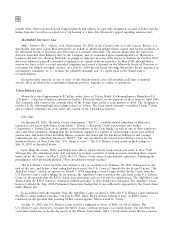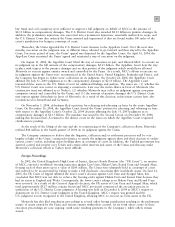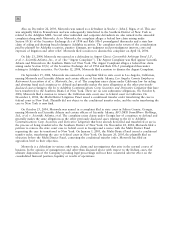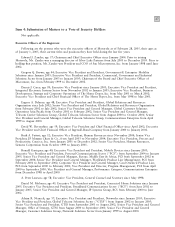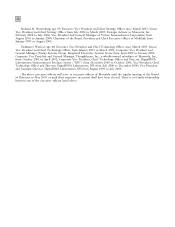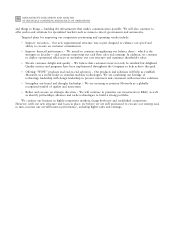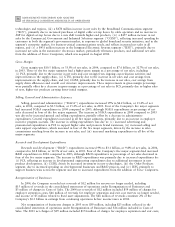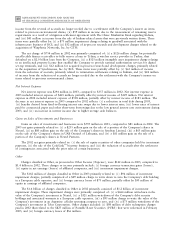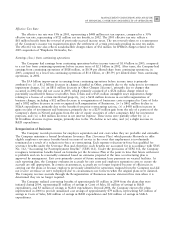Motorola 2004 Annual Report Download - page 40
Download and view the complete annual report
Please find page 40 of the 2004 Motorola annual report below. You can navigate through the pages in the report by either clicking on the pages listed below, or by using the keyword search tool below to find specific information within the annual report.
32 MANAGEMENT'S DISCUSSION AND ANALYSIS
OF FINANCIAL CONDITION AND RESULTS OF OPERATIONS
Freescale Semiconductor to Motorola shareholders. As of that date, Freescale Semiconductor is an entirely
independent company. The Ñnancial results of Freescale Semiconductor have been presented in Motorola's
consolidated Ñnancial statements as a discontinued operation.
What were our key 2004 Ñnancial results?
‚ Our net sales were $31.3 billion in 2004, up 35% from $23.2 billion in 2003.
‚ We generated operating earnings of $3.1 billion in 2004, compared to operating earnings of $1.3 billion in
2003.
‚ Our earnings per diluted common share from continuing operations were $0.90 in 2004, compared to $0.39
in 2003.
‚ We had positive operating cash Öow of $3.1 billion in 2004, compared to $2.0 billion in 2003, and have
generated positive operating cash Öow in each of the last four years.
‚ We reduced our total debt* by $2.7 billion in 2004, from $8.0 billion to $5.3 billion.
‚ We are in a net cash** position of $5.4 billion at the end of 2004, compared to a net debt** position of
$99 million at the end of 2003.
‚ We had net reversals of $12 million for reserves no longer needed relating to reorganization of businesses
in 2004, compared to net reorganization of business charges of $39 million in 2003. The net reversals of
$12 million in 2004 included $59 million of charges for employee separation costs, $66 million of reversals
for employee separation and exit cost reserves no longer needed, and income of $5 million related to Ñxed
asset adjustments. The $66 million of reversals constitute 2% of the Company's $3.3 billion in earnings
from continuing operations before income taxes in 2004.
What did we focus on in 2004?
In 2004, we were focused Ñrst and foremost on increasing proÑtable sales and growing market share. We
increased our net sales signiÑcantly, with 35% growth in 2004 compared to 2003. We also achieved our goal of
increasing the proÑtability of these sales, as evidenced by the 146% increase in operating earnings in 2004, compared
to 2003. Operating earnings increased in four of the Company's Ñve major segments. Contributing to the
improvement in proÑtability were: (i) improvements in supply chain processes in PCS, GTSS and CGISS, (ii) overall
cost-structure improvements, (iii) ongoing cost reduction activities, and (iv) improved average selling price
(""ASP'') in PCS due to a product mix shift towards higher-end products.
In addition, we believe we improved our market share position in our two largest businesses, PCS and GTSS.
Both the wireless handset and wireless network industries experienced signiÑcant growth in 2004. In PCS, total unit
shipments outpaced the industry as our market share grew and we solidiÑed our number two position in the
worldwide handset market. In GTSS, the business' net sales growth was larger than the wireless infrastructure
industry, also resulting in increased market share. In addition, CGISS remains the market share leader in supplying
two-way radio communications systems, and BCS remains the market share leader for both digital set-tops and
cable modems.
What challenges and opportunities did our businesses face in 2004?
‚In PCS: Our wireless handset business had a very strong year in 2004, reÖected by a 53% increase in net
sales, a 257% increase in operating earnings and increased market share. The increase in net sales was driven
by an increase in unit shipments, which increased 39% in 2004 compared to 2003, and improved ASP,
which increased 15% in 2004 compared to 2003. 2004 was a record year for the wireless handset industry,
as total industry unit shipments increased approximately 25% compared to 2003. Our wireless handset
business increased its unit shipments 39% to 104.5 million and, since this growth outpaced overall industry
* Total Debt • Notes Payable and Current Portion of Long-term Debt ° Long-term Debt ° Trust Originated Preferred Securities(""TOPrS'')
** Net Cash (Net Debt) • Cash and Cash Equivalents ° Short-term Investments - Notes Payable and Current Portion of Long-term Debt -
Long-term Debt - TOPrS


